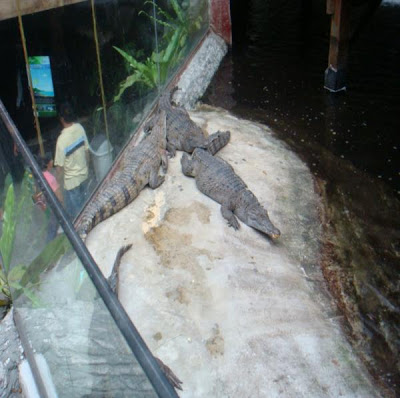After a While Crocodile!
Have you ever seen an alligator in person? Technically speaking I have only seen an alligator in one of the aquarium I had been to. Well, they are not scary as I though it would be. I guess crocodile is more dangerous and scary than alligator like the one in the movie Rogue. This is what I learned today from Wikipedia about this creature and what makes them different from crocodile. So, see you later alligator!….After a while crocodile lol.

Kingdom: Animalia
Phylum: Chordata
Class: Reptilia
Order: Crocodilia
Family: Alligatoridae
Genus: Alligator
An Alligator is a crocodilian in the genus Alligator of the family Alligatoridae. There are two extant alligator species: the American alligator (Alligator mississippiensis) and the Chinese alligator (Alligator sinensis).
The name alligator is an anglicized form of el lagarto the Spanish term for “lizard”, the name by which early Spanish explorers and settlers in Florida called the alligator.
There are many adaptations for the American alligator. Baby alligators have an egg tooth that helps them get out of their egg during hatching time. They also have a muscular flat tail that propels them forward while they swim.
The alligator is notorious for its bone crushing bites. In addition, the alligator has been described as a “living fossil from the age of reptiles, having survived on earth for 200 million years.”
What is the difference between alligators and crocodiles?
Differences between alligators and crocodiles
While alligators (and caimans) are often confused with crocodiles, they belong to two quite separate taxonomic families.
The most obvious external differences are visible in the head—alligators and caimans have wider and shorter heads, and a more U-shaped than V-shaped snout. The alligator’s upper jaw is wider than its lower jaw, and the teeth in the lower jaw fit into small depressions in the upper jaw. The upper and lower jaws of the crocodiles are the same width, and teeth in the lower jaw fall along the edge or outside the upper jaw when the mouth is closed. When the crocodile’s mouth is closed, the large fourth tooth in the lower jaw fits into a constriction in the upper jaw. For hard-to-distinguish specimens, the protruding tooth is the most reliable feature to define a species. However, in captivity, alligators and caimans may show jaw deformities which result in lower teeth protruding.
Alligators lack the jagged fringe which appears on the hind legs and feet of the crocodile and have the toes of the hind feet webbed, not more than halfway to the tips. Alligators strongly prefer freshwater, while crocodiles can better tolerate seawater due to specialized glands for filtering out salt. However, both taxa can survive in either.
Both species of alligator also tend to be darker in color than crocodiles—often nearly black (but color is very dependent on water quality). Algae-laden waters produce greener skin, while tannic acid from overhanging trees can produce often darker skin.
When cleaning alligator pools, some zookeepers can tread on alligators without eliciting a response, though crocodiles almost invariably react aggressively and are for the most part more aggressive in their natural habitat.
Crocodilia (or Crocodylia) is an order of large reptiles that appeared about 84 million years ago in the late Cretaceous Period (Campanian stage). They are the closest living relatives of birds, as the two groups are the only known survivors of the Archosauria. Members of the crocodilian stem group, the clade Crurotarsi, appeared about 220 million years ago in the Triassic Period and exhibited a wide diversity of forms during the Mesozoic Era.
The correct vernacular term for this group is “crocodilians” and it includes the alligator, crocodile, gharial and caiman families. The term ‘crocodiles’ is sometimes incorrectly used to refer to alligators and caiman, or even their distant prehistoric relatives, “marine crocodiles”.
Source:Wikipedia









